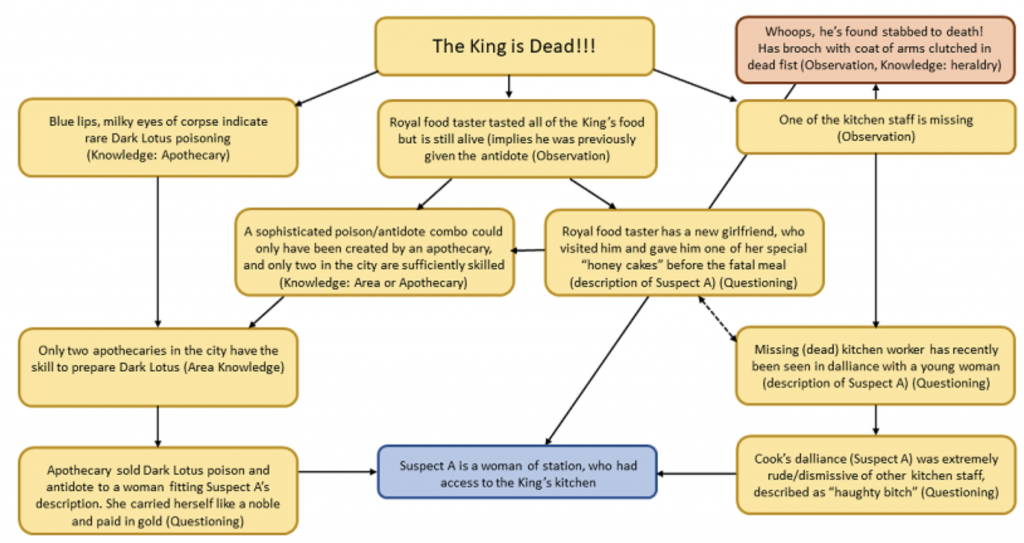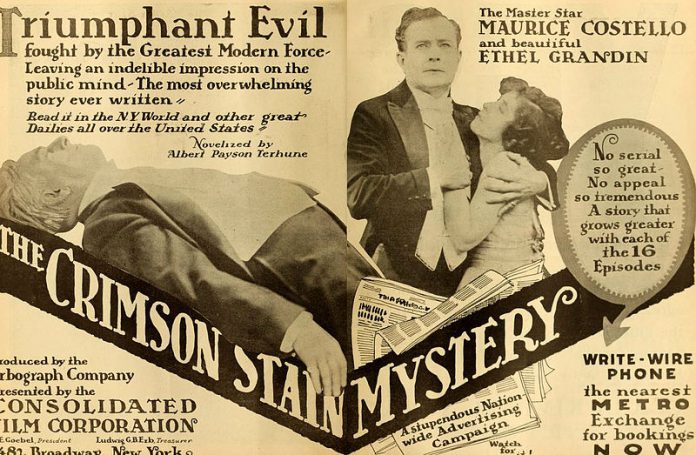Running a true murder mystery game can be a daunting undertaking. Many TTRPG campaigns have a mystery at the core, but that works in the GM’s favor as they have the opportunity to change unrevealed information as the story progresses. But if you’re trying to let your players go all Sherlock Holmes, you have to stay consistent. How do you plot out an entire mystery with fun clues and exciting twists that your players won’t instantly figure out? How do you make sure that they can figure it out on their own?
Turn Order is here to help! We’ve compiled some tips and things to consider as you write and run your game. Remember: as long as you and your players are having fun, you’re running the game correctly. From our experience, these ideas will help you to run a satisfying mystery story no matter the system or exact plot you use.

Choosing a System
Rob: When you’re choosing the game system you’re going to use, keep in mind what the fundamental assumptions of the setting are, as they’ll inform the amount of work you have to do when it comes to physical evidence of the crime. After all, the point of a murder mystery campaign is for the players to actually solve the mystery, or at least to have a fair shot at doing so. And as part of their investigation toward that end, at least one of your players is going to want to do forensics. And that means you have to know what sort of evidence is there, as well as how players can look for it and what it might mean
In a setting that more closely approximates the real world, there are a ton of resources you can lean on to map out the connections between the physical clues the players might find and the conclusions that they’re intended to lead them to draw. For instance, things like fingerprints, blood spatters, and trace evidence of gunfire (like muzzle burns or discarded shell casings) are all things that could be included at or near the scene of the crime for enterprising players to apply their skills to and get actionable clues.
But this doesn’t necessarily work so well when your setting fundamentally assumes the presence of things that the real world doesn’t allow for. For instance, magic in D&D: everyone in that world knows it exists, and they all know that there are at least some signs of its effect, at least while it’s still working. Beyond that, though, a lot of answers to questions regarding how it all works are just sort of handwaved away.
And while that’s fine for most situations, where you’re more concerned with what happens when the spell is cast than how it got cast or what the lingering aftereffects are, the parts of magic that don’t usually offer anything but some neat flavor on an otherwise generic spell can wind up being the most important parts of that same spell for a PC investigating a crime. Evidence of the method of casting might reveal that the caster of a spell was a wizard rather than a sorcerer or warlock, while magical residue might leave some clue that would identify a particular caster’s individual style.
Ilor: While most of us tend to favor game systems with which we or our players already have familiarity, it’s worth noting that there are a number of systems out there that really lean into running investigation-based games. Maybe rather than using D&D, you might want to look at “Trail of Cthulhu” (which in turn uses the “Gumshoe” system that is designed specifically for investigations). Similarly, Mike Sands’ “Monster of the Week” has player-facing mechanisms that are specifically geared toward solving mysteries. Even if you want to stick with a particular ruleset, checking out some of these other games and stealing ideas from them can be of great help.
Josh: I can’t stress this enough—Systems focused with a majority focus on combat, or a generalist approach like D&D & Pathfinder aren’t always the best choice. It’s possible to run a great game of any genre on them, of course, but if you’re invested in running a specific type of game then you can set yourself up for success by picking a system that’s tailor-made for that vibe. It’s a perfect excuse to explore the wider world of TTRPGs, and maybe you’ll find something you absolutely fall in love with! Ilor gave some great suggestions above, and you can also check out our article here to take a look at some more.

Skill Checks & You
Josh: When creating a mystery inside of a game system, it’s pretty normal to want to gate things behind the mechanics of the game itself — investigation checks, persuasion tests, logic rolls, all the things that make up the G of our TTRPG.
If you’re an emerging DM who’s finding their storytelling feet, it’s careful to consider how you view failed skill checks. It’s easy to default and treat them as you’d treat it in any other scenario — the player has failed, and they don’t get what they want. You missed the clue. You didn’t spot the subtle eye-twitch on the butler’s eye. You failed to achieve your eureka moment.
With this approach, a campaign that is entirely focused around solving a mystery, a string of unlucky rolls can quickly spiral into every avenue the players explore becoming a dead end. It’s frustrating for you and your players, as you scrabble to find a way to get them back on track to solving the mystery (something you probably want them to do) and the players are taken out of the experience and demoralized on top of it.
One of the best bits of advice I ever uncovered was reconsidering what failure means. Much like life, getting rid of the binary opens up so many options to make your life easier and more interesting as a DM. Systems like Wrath & Glory laces this philosophy throughout, encouraging DMs to consider failure as a hassle, not a roadblock. It applies pressure to the players, as the failure costs them resources—like time, equipment, or reputation—anything you can think of.
On the trail of a serial killer? Failing a check means they have time to strike again. Investigating the scene of a crime? You’ve taken too long, and the actual law enforcement need to be haggled with to let you stay. Inspecting a body? You’ve disturbed the corpse and lost a little bit of forensic evidence. The world is your oyster—just remember, you want the players to progress, even if that progress isn’t always on the straightest path they could’ve gotten. Give them something, even if it isn’t the whole thing. Muddy the context. Stretch the time. Consequences that give them more to hook their teeth into.
I’m often reminded of Disco Elysium. (RIP to a real one) Failure can be as engaging and interesting as success. If you need any other benefit to adapting your mindset, you’ll notice your players get a lot less nervous about failing—so many times, I’ve had groups who were terrified of failure, because they’re so used to it being an immediate, mechanical consequence. They fail, totally, and that’s it. Obviously, failure should bring consequences, and no matter the type of consequences, it should be something that propels you and your players narrative forward rather than stopping it in place.
Setting and Genre
Luke: Decide your genre and setting early on. While a realistic world may help you and your players know what clues should look like and how to find them, you may prefer a fantasy or sci-fi game. That still works, as long as the table understands what they can expect. If your grimdark cyberpunk dystopia features a well-known criminal presence and death around every door, you need to make it clear why this crime stands out. If your high magic fantasy land is full of powerful wizards, there should be a reason the villain resorted to murder despite all the spells at their disposal. Be open about what resources the characters have access to and make clues accessible if they use those resources correctly. Setting consistency is most important, because if your villain has unheard of powers to prevent being caught, that stops being a fun challenge for the players.
Ilor: In modern settings there’s another important aspect to consider: is the game taking place before or after the advent of cell phones or smart phones? It’s a hell of a lot easier to solve a crime if you can take a quick snap of a symbol carved into the victim’s flesh and do a Google reverse image search to find that it is associated with a murderous cult. It also makes it much easier for the PCs to divide-and-conquer, allowing them to share information easily or warn each other that the murderer may be onto them. I have a friend who refuses to run any kind of mystery-based RPG after about 1980 just because cell phones ruin everything. While his stance is a little extreme, he’s not entirely wrong.
Luke: This is also a great time to figure out your game’s tone. Let’s be honest, you can plan for Sherlock and Watson all you want, but most players are going to be much closer to Inspector Clouseau or Shawn Spencer. (We’ve all seen Psych, right?) Make the situation clear! If your characters are detectives, do they need to be professional and handle evidence properly? If they’re unlicensed randos, do they need to avoid getting caught investigating? Placing some constraints on what players are allowed to do can raise the stakes and actually make space for some creative decisions. Your players are going to want to do bits and goof off a little, so know what the consequences are for going too far. This may be worth mentioning as you pitch the campaign and create characters, but will mostly come out during play. If you’re cool with a pure comedy, the characters can probably get away with a lot more strange behavior than if you’re trying to create a more serious atmosphere.
The Mystery Itself
Luke: Okay, you’ve picked out a system and figured out the world you want this story to happen in. Now you have to figure out what will create the actual mystery. As I see it, there are two general ways to figure this out.
If you already have a story idea in your head, great. All you need to do is figure out how that fits in your world. Invent your culprit and figure out their backstory. Write out exactly how they committed this crime: the process of planning, any weapons involved, how it actually ends up happening and where the culprit and any physical evidence goes afterward. Just from that, clues should appear to you. Will the bullet fired help to identify the type of gun used? Did the murder happen somewhere muddy, where footprints could have been left behind? Did letters or texts have to be exchanged between co-conspirators? Go back through what you’ve written and pull all this out. If it feels a little sparse, add stuff in. If all your players will have to go on is a weapon, maybe decide that the culprit left fingerprints on something obvious nearby.
If you have your world in mind but no mystery, you can always start by thinking about genre-appropriate crimes or stealing something from a piece of media you enjoy- but the risk is always that your players may have also seen the same thing. A good way to come up with an entirely original mystery is to start by constructing a cast of characters, especially if your story is set in a limiting element like in Knives Out where you know the killer was someone in the house. It’s fun to play into tropes of your genre; my mystery campaign is set on a train in a historical fiction version of the 1920s, so I have everything from a mysterious widow to a grizzled cowboy. Once you have most of your “cast” planned out, go through and figure out a potential motive for each of them to commit a crime against a different cast member. Could these two have a romantic history? What if this one is jealous of someone else’s share of their inheritance? What if the crime isn’t actually about the victim, but has some greater motivation? Then, follow that same process of writing out the actual events of the crime and figuring out what clues must have been involved.
Keeping Your Story Straight
Ilor: One way to help you organize your mystery is to create a “clue web” for yourself. That is, for each clue or piece of information the players find, have some sense of where it might lead them, and that in turn may lead elsewhere. But importantly, try to make sure that there are at least two ways to get from one point to another. For example, let’s say that the King has been poisoned and we want to give the players some clues as to who may have been responsible. That might give us a clue web like this:
This is just a handy way of organizing things such that there are multiple ways the players can get to the same information. You can also keep track of what clues the players have gotten and which ones are still out there for them to discover.
This kind of approach can be really important because what might seem obvious to you (e.g. that you can buy a particular poison from an apothecary) might never occur to your players. A general rule of thumb is that each element of a crime should have three clues that point to it. A note on “red herrings”: the above guideline is for three real clues. If you’re going to use red herrings (false clues that lead the PCs away from the real solution) be exceedingly careful! They can be incredibly frustrating for players, especially if they spend a lot of time, effort, and resources following a trail that leads nowhere. Use them sparingly and never have more than one red herring leading to the same (false) conclusion. Further, never have them point to each other. My favorite use of red herrings is to turn them into clues by making the red herring represent the true culprit deliberately trying to throw the investigators off the trail. If the players can determine that the clue is false, then it can give them information about who could have planted it, which in turn should lead them in the right direction!

Luke: Making this web can seem daunting, but you don’t necessarily need to map every single step out. Figure out what happened: who was murdered, by whom, how, why, where and when. The witnesses or physical clues that would be created by this crime should reveal themselves naturally as you follow the logic.
Here are some more ideas for keeping your information organized:
- Two-column notes: On each page of your notes, write everything you know as the GM. Whenever a piece of information is revealed to your players, simply move it over to the second column. This clearly shows what everyone knows and can allow you to remind players about previously-gathered clues without accidentally letting extras slip.
- Virtual table-tops or other shared sites: VTTs are helpful if you have any kind of map, even if it is just one room. A visual representation of the crime scene can keep the story clear. Many of these sites also allow you to share notes with your players. Consider providing information about major NPCs or locations to reduce the amount of time you spend answering the same questions.
- Shared player notes: If you’re a GM, this is out of your control, but it might be worth suggesting that players share notes. After all, this is a cooperative game. If everyone pools information, they’re all more likely to successfully solve the mystery.
Ending Your Story
Luke: Unlike what we tend to expect from a campaign, mystery stories have a pretty concrete ending: the characters solve the mystery. Maybe they still have to actually catch or expose the killer, but once all the details have been revealed, the rest tends to feel more like an epilogue. This can be stressful for a GM! When players sign up for a game, they’re expecting to commit for a certain amount of time. What if they solve the mystery after two or three sessions?
You can always build in some failsafes to extend the mystery through multiple layers of the villain’s plan, but obfuscating the plot even further can just make it less fun. The main solution, as for many things in these games, is communication. Let the players know up front that the length of the game may vary wildly depending on how quickly they make connections between clues. If your table is like mine and rotates GMs, whoever has an idea for a campaign can start making plans for the next game. If you’re the forever GM or if this is a one-off game, consider making a plan to continue with a different plotline if everyone is still having fun after the mystery. I’m using Vampire: the Masquerade for my mystery, so we decided that we’ll jump forward in time and play a more traditional game about clan politics.
No matter whether your game ends with the mystery or continues afterward, be comfortable with getting to the resolution at a natural speed for your party. The game will be more enjoyable and memorable for everyone when you put that power in the hands of your players.


